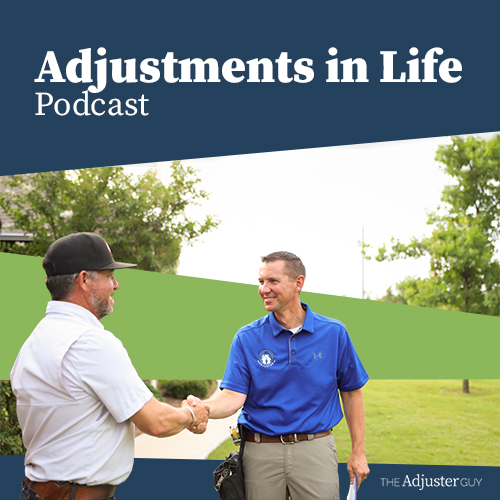Transcript
Alan: Well all right folks. We are back in the saddle again. Welcome back to another episode of Adjustments in Life podcast again.
I’m your host, Alan Olson; and I’m alone again today. My trusty sidekick and cohost, Mr. Jason Dyson, decided he needed a little getaway and go fishing this this week. So he is not joining me; he is surely missed, but life goes on and we keep on moving on and keep trucking and get you the information that you guys are asking for.
And I did two weeks ago, I told you guys to reach out and let us know what you wanna hear. Respond to us and help us to get the information out to you that you’re needing. And you did it!
I’ve gotten tons of responses via Facebook, a couple have reached out and responded to The Adjuster Guy website; but thank you. Thank you for expressing to me that the knowledge that you’re looking for and the things that you want me to share with you.
One of the things that probably is the most common question so far in this venture of them getting you guys out in front of me to tell me what you want to hear. It stems from most of the newest adjusters that are just getting into the field and don’t really know the ins and outs yet.
But I keep getting asked what should I do? Should I run daily claims or should I be a CAT adjuster? Guys there is a ton of answers to that. Alot depends on what you want to do, the region of the country that you live in, what your goals are—all the things that you can imagine you would think of in any job, you have to take into consideration.
Some of us get the choice in the beginning to choose where we want to go in this industry. Some of us don’t. Some of us take the ride for what it is, we end up where we end up, and we don’t get a lot of choices along the way.
I believe that everyone of you is likely to get an opportunity to try just about every avenue of adjusting that you can try, if you want to. I have done primarily property, but I’ve done auto as well—I didn’t really care for it that much.
But I know several guys in the industry that they love to do auto. They don’t wanna do property they just stick to the auto because that’s their thing.
But I’ve done commercial, I’ve done liability, I’ve worked just about every spectrum of property claims that you can work or non-auto or non-office. I am not the guy that loves to sit at the desk all day long and deal with people over the phone.
So I primarily stayed out in the field, moving along doing property claims and that’s where my heart is. As I age, I think that commercial is starting to become more my cup of tea. It’s a little bit different pace, little bit different type of way of handling invoicing; but I enjoy it.
I like the complexity of the claims; but again, I’m seasoned enough that I’ve gotten to choose a little bit more about where I go. But I think everyone of you will get those opportunities if you look for them. And you’ll start to be able to make choices of where you wanna go in your career.
Now is there there is a difference in somebody that wants to run day claims versus CAT, so let’s break it down a little bit because we need to understand what the responsibilities are and what each title represents to kinda know which direction we may wanna pursue if we get the opportunity.
Along with this, I get the same question directly after—what should I be or a daily claims adjuster or a CAT adjuster? Do I get to work from home?
Typically, if you’re a daily claims adjuster, you are working from home 99% of the time. If you’re going to work day claims, you’re going to work from home. So what does that mean?
Well, it means exactly that—if you’re gonna dedicate yourself to being a daily claims adjuster, you’re gonna work your area or you’re gonna try to. Sometimes your area can be 200 square miles.
I know folks that never leave the state of Texas, but they handle all of the state of Texas. And that’s a very large area to handle; but you’re gonna work primarily from home.
Home meaning—if you can be home every night, great, be in your own bed. You may not. You may be working two days out on the road getting a hotel room one of those nights and then you’re back at home.
That’s still considered a daily claims adjuster working from home. What kind of claims would a daily claims adjuster handle?
Well you’re gonna handle just about everything. So, yes, to be a day claims adjuster, you’re probably gonna be working from home and you’re going to be handling every type of claim.
Now before I get carried away with just saying you’re only gonna work at home and you’re going to work all these different types of claims, typically when you work day claims you’re going to work everything that involves a day-to-day process of claims that come in—meaning a water leak under the sink and a toilet leak.
You might get a hail claim, you might get a wind claim, you might get a car ran off the road and went through my fence, you might get a vandalism claim, you might be working liability claims, or—if you have a broad enough spectrum of clients that you work with—you might handle something to do with farm and ranch or crops.
You’re taking all the claims that you can obtain in your area that you’re going to work or that you’ve committed to; and you’re going to handle all of those claims all at the same time.
You may have claims that you can close that day, you may have claims that take you a week to close; but you’re you’re generating a business that is local to your area, you’re working with multiple firms typically.
Not very many day claim adjusters are only gonna work for one firm. You might work for 10 firms. You may get 90% of your work from one or two firms, but you’re likely going to be working for every firm that you can make contact with in that area, because not one firm can typically keep one adjuster busy year-round working from home.
The volume spikes and drops and spikes and drops. So you get a wide variety of different types of claims and your volume goes up and down. Some weeks you may be working for 10 different firms and you may only end up with 10 or 12 claims.
There’s gonna be periods of time where you have a small pocket storm or some type of event take place in an area near you. And you’re going to be handling claims for everybody; and you may get overwhelmed or you may have to cut a few off and say I can only run a few claims for these two firms right now because they give me the biggest percentage of my claims.
But you need that to be a day claims adjuster; you need that connection with all the other firms in the area so that you can—even during the times where there’s no big event—you can get enough claim volume to satisfy the needs of what it takes to feed your family or to to make the set amount of income that you prefer making.
I’ve done it both ways. I have worked day claims in my area several different times throughout my career; and it worked out fine—I found myself working pretty steadily.
Again I had to have about maybe on average I was taking claims from 5 to 6 different firms all at the same time; but I was able to manage to keep up enough volume to live comfortably.
And when you add that up over all weeks of the year all year long, I could make on average approximately not quite as much as a CAT adjuster, but on average I would do probably 80% or 60 or 65% to 80% of what I can make is a CAT adjuster, I would make at home as a daily claims adjuster and never have to leave the house.
So you know but it just takes the effort of getting out there, being willing to take whatever claims they’ll give you—whether they’re complex claims to work or very very easy claims to work—you have to be willing to take them all and you have to be willing to have that relationship with everybody and take in as big as volume as you can constantly keep going in your area in order to make that work.
So if that’s the kind of adjuster that you want to be—you don’t want to have to leave town, you got a family, you wanna stay home, you want to try to be home on the weekends to go do things with your kids—theres nothing wrong with that.
That’s the main reason I did it in those yours was so that I didn’t have to leave town. My kids were at certain ages that I really wanted to be home; and so I utilized my resources to create enough volume as a day claim adjuster in my area that I could live and support myself.
It’s not for everybody. It gets stressful. You work harder—chances are. You’re going to work harder at home running the claims because they’re not cut and dry claims that are associated with that storm that are like clockwork.
You can roll through them and close them and make them go away. There’s going to be a lot that you gotta obtain more information or you got to work with a contractor. Since you’re local, every time there’s a supplement it comes back to you and you got to work that supplement to continue the file moving forward.
Again not a bad situation to be in because you’re securing your position as a day claim adjuster in that area. If you do exceptionally good work, the firms are going to continue to use you and they’re going to they’re gonna do everything they can to keep you there. They don’t want you disappearing because if you’ve done things right you’ve become a value or an asset to them to have in that area to handle those claims.
And if you’re dedicating yourself to being a daily claims adjuster in that area, they know you’re not gonna leave. They know you’re gonna be there. When the big storms come, you’re not gonna runoff. So if you can give them that commitment then they are going to be more inclined to commit to you to keep a steady flow of claims going in your direction.
Again you’re not gonna do this typically with one firm. It’s going to take multiple firms in order to get this accomplished. Now I keep saying at home, at home, at home.
You can be a daily adjuster in a different location other than home if that’s the way you prefer it. You don’t have to be a CAT adjuster in order to leave your house and go work a storm somewhere else.
I can tell you right now offhand any of the West Coast states typically the northern states—Montana, the more rural states as well—they need they claim adjuster’s year-round to deploy in, handle claims in that area for a period of time, and then if you want to stay there, stay there if you don’t, leave—they’ll move somebody else in.
I myself have made two trips to Washington State and sat there for 90 days or longer running day claims in that state or in that region of the country. I wanted to leave home. I want to deploy; but I didn’t want to go out into the rat race of the biggest and hardest storms that everything‘s going crazy and it’s just chaotic because it’s a catastrophe.
I wanted to be out and away from home. I want to be on deployment somewhere; but I wanted a steady pace of claims that I could go run my claims, go back to my RV, and sit and enjoy life at the same time.
Things might be different right now with the Covid restrictions; but for years if you were anything remotely interested in working Washington, Oregon, or Idaho, there was a generally an open opportunity for a good day claim adjuster to go deploy into that area, sit there for 90 to 120 days—which ever you can negotiate it out with the firm that was deploying you—run whatever requirement of claims that was required in a day and be able to go and sit back and enjoy an evening meal and not be strapped to the grind in the hours of being on deployment on a catastrophe.
So there’s pros and cons to it; but that kind of breaks down and gives you an idea of what a typical day claim adjuster does and how that would work. How that would look—whether you were doing it from home or whether you’re doing it on the road.
But now mind you, if you’re doing a day claim adjuster out on the road you’re typically not going to need to engage or want to engage multiple firms. If a firm has deployed you to that area to be a daily claims adjuster—especially if they put you on a day rate—you don’t need another firm, you don’t want another firm, you can get yourself into trouble real quick if you’re turning on multiple firms while you’re trying to do day claim work.
Unless you’re trying to be that adjuster that is working day claims from home and just trying to handle your particular area or whatever’s within arms reach of where you live. I live about a little west of the Dallas-Fort Worth metro area; and so anywhere in that region is my backyard—is a day claim area for me.
If you don’t live near a metropolitan area, it can be a little more difficult; but again there’s still claims out in those rural areas that need to be run. It’s just a different type of claim.
That’ll give you a kind of an idea. I mean I can go into more and more detail. I could go into different scenarios; but that kind of gives you an idea of what a day claims adjuster is going to do and handle and how that looks. If that’s appealing to you, look for those opportunities.
I did that. I tried it. It wasn’t my cuppa tea. That’s why I didn’t stay with it. I utilize it for opportunities with my family and my kids when I could; but guys in my heart I am a catastrophe adjuster.
So let’s break that one down. A catastrophe adjuster—what does a catastrophe adjuster do? Well we are the hard hitters. We’re the ones that want to go into the biggest storms, get there, hustle, get they’re last minute phone call, hustle get there, set up, run, accept the claims, run as many claims in the days as we can, stay ahead, get as many claims out of that storm as we can, and then when we’re done—when the volume drop—we pull the plug and we either go home or we go straight to the next storm and keep doing the same thing again.
So what are the key things about a CAT adjuster? Well typically you’re not going to work from home much. In fact most true catastrophe adjusters don’t wanna work from home. They wanna get out on the road and work and then when they come home they don’t wanna think about work.
They want to take that time off or they want to spend that time with their family or they wanna go vacation. Whatever their prerogative is and how they wanna live their life they work, work, work, work when they’re deployed and they go home and play the rest of the time.
So your claims are going to be on a travel basis only. You’re not gonna run—a true CAT adjuster’s not gonna run I run a huge variety of all different types of claims. They are there to focus on whatever claims are pertinent to whatever catastrophe event took place that got them there.
It’s a hail storm in the Midwest. They’re going there to run as many hail claims as they can run and get out of there.
It’s a hurricane in Houston, Texas. They are going to go to the coast. They are going to run as many hurricane claims or hurricane related claims—now course that could be a variety of different types of loss all at the same time—but they are going to run specific claims to that hurricane—related to that hurricane until the volume drops and it’s over with and then they’re gonna pull out and go home.
We had a freeze event in the Northeast. Again leave the house, drive there, handle as many claims as they can handle in the time period that they’re there. They’re focused on the claims that came in for that specific event. They don’t wanna run toilet leaks, they don’t wanna deal with vandalism claims, they don’t want anything that’s going to typically be a complex or drawn out claim.
They’re there to turn volume. A typical CAT adjuster is there to turn volume, not handle the supplements and everything that goes along with a complex claim that’s going to last six months. If a can adjuster runs into a claim like that, typically the job is that you write the estimate, you can scope it, you write the estimate, and you handled it to the best of your ability as far as you can get it on the initial visit and then you send it back in, you pay them all the undisputed damage that you can pay them for and then somebody at the desk or another adjuster customer will take that file should the supplement start coming in or that file needs to be reopened.
Typically going to go to whatever daily claims adjuster is in that area. So again that’s another piece of what the daily claims adjusters gonna do is he’s going to handle supplements or any reinspections that come from whatever catastrophic events happen anywhere in or near that daily claims area.
So a CAT adjuster traveling typically only travels and the claims that they’re running you’re going to be focused more on one specific event instead of just what ever needs to be handled in this region at any point in time.
Again it’s not going to be a CAT adjusters do not set themselves up for a somewhat scheduled, low workload or medium workload situation. Where the daily claims adjuster is going to do their 2 to 4 daily claims most likely and then call it a day and enjoy your evening and then start again the next day.
The CAT adjuster is going to handle—he’s going to work at a higher rate of speed. He’s there to handle as many claims in a day as you can. And let me tell you I have spent on many, many storms where a 16 to 18 hour day consistently seven days a week the whole time I was there was not uncommon.
That is a typical CAT adjuster work schedule. I typically am up by 5:30 or 6 every morning, getting prepared when I’m on a CAT so that I can be on my first inspection by 8 o’clock.
If I’m in Texas, I’m probably gonna start hail inspections in June at 7 AM if the insured will let me come that early, because it’s too dang hot. And then I’m gonna get as many in in a day as I can to close that evening.
So again we’ve talked about that before, CAT adjusters are going to work as many hours as he can, but he’s still only going to inspect what he can get closed that day, but sometimes that takes me ‘till a minimum of midnight. On some occasions, I might be up until 1 AM or 2 AM; and I’ll do that consistently seven days a week during a catastrophic event because I’m a CAT adjuster.
At that point in time, I’m not I’m not the guy that’s gonna sit there and do a few claims a day. I’m there to get as many turned as I can for the firm and for the carrier so that we can get this catastrophic event wrapped up as soon as possible. And everybody meets the service level standards that we’re upheld to.
So that’s kind of the gist. And really and truly you got to make a decision on what you’re going to prefer. What’s your cup of tea? What kind of an adjuster do you want to be?
You may not actually ever get a choice. You may get stuck with whatever you get and that’s okay. Neither one of them are a bad gig. Money-wise you can make both of them turn out to be exactly the same income either way you go.
Now I will say this though that the biggest difference in income you will see on a daily claims adjuster versus a CAT adjuster is that CAT adjusters typically probably gonna make a little bit more than a day claim adjuster—not on every occasion and not on every year.
Well let me back up a little bit because if you’re a daily claims adjuster and you’re claim volume is not driven by catastrophic events, you’re likely to be able to build a business at home that is going to give you a somewhat steady flow of claims.
Again being a wide variety of different claims from a lot of different firms, but once you build your reputation and your commitment as a daily claims adjuster you can retain that year-round—whether there’s a catastrophic event that takes place anywhere because your business is not necessarily driven on what weather events take place.
Your business is being driven on the every day claims for any other reason. And let me tell you there’s tons and tons and tons of them that get turned in that are easy claims to work because it may be something very simple that’s not even covered, but you still got to go document it and close the file.
But there’s a steady flow of daily claims that come in for—like we’ve talked about—toilet leak, pipe leaks, leaks under the kitchen sink, birdstrike on the window, I mean you name it there’s covered claims out there that are coming in every day.
You’re still making that money. If you’re strictly a CAT adjuster, you need to be prepared that we will have slow years. We will have years were there are nearly no catastrophic storms to work—none.
I have I have seen it; and I know guys that I’ve gotten out, have had six years of nonstop catastrophic events, and then all of a sudden we get two years of almost nothing.
And when I mean nothing—if you go work one small hail storm and end up getting 30 claims and then it turns off and nothing happened—that 30 claims may be all you work for the year. That’s no fun. That makes for a rough year when you’re dependent on catastrophic events to take place.
Now the day claims adjuster is going to grind it out. He’s gonna be working all year long. And even on a year where there’s no catastrophic events, a daily claims adjusters volume is probably gonna dip down and be a little less than normal as well because some of their daily claims are driven on the weather.
But they’re going to be able to maintain a steady flow and a bigger income on real dry years of weather activity than a CAT adjuster.
I still prefer—me alone—I still prefer being a CAT adjuster. I like being able to make my annual salary in the 5 to 6 maybe seven months of weather activity months that we typically work. And be able to have the rest the time off.
But I have to also—like I already said—I have to be prepared for those years that there is no major catastrophic events and make sure I can sustain. And some companies, some firms that you work for, will give you the opportunity to work a little bit of those day claims to help when times get tough.
But keep in mind, when times get tough, they get tough for everybody. And they’re still only so many claims that can go around even in the day space or the daily claims.
Which are you? Which do you wanna be? How do you want to set yourself up? Do you want to go in one direction? Does the day claims look more interesting to you or more satisfying because it may be a more solid income?
Do you want to go with the CAT? Do you want to stay out there and then be on the road and work really hard and come home and play? But there’s a little bit a risk that goes with that in order to maintain as easily as the guy that has a steady flow of claims from home, where he has no expense but he could be at home.
It’s up to you. And again some of you are going to get this choice right up in the front of your career. And you can lean in whatever direction you wanna go. Some of you won’t get a choice. You’ll never get an opportunity. Because of where you live, to add yourself to the daily claims area because there’s too many other adjuster’s trying to do it.
Or you may be able to just say “I only want to be CAT. I can do other things in the meantime. I can work other jobs. I have connections elsewhere. I just want to go work CAT and make whatever I can make when I work and be satisfied with that.”
It’s all up to you. Again I say that I’m kind of telling you two answers at the same time; because, again, some of you will get a choice some of you wont. But I guess what I want you to know is, if you get that opportunity, you have to pick. You have to choose which direction you wanna go.
And neither one of them wrong, neither one of them are a bad way, and neither one of them are the best way. It comes down to personal preference and where you wanna go and the direction you want to take your career.
And you can change—that’s the glory of all of it—you can change your direction at any point in time. All you gotta do is inquire, talk to the firms, reach out to store managers, let them know what you want and where you wanna go.
If they can’t if they can’t put you in that position right now, what positions do you have or what areas that I have that can work me in that direction. It’s that easy.
Communicate with your firms, communicate, network with the people that you know, find new resources, and connect. That will get you where you want to go. But first you got a fill it out.
So take whatever they give you and then fill it out from there. So be whatever you want. Be a day claims adjuster. Be a CAT adjuster. It’s all going come out where it’s got to be in the end.
It’s just whatever route you take there. And again there’s 1000 roads that all lead to the same spot. So that should give you a little bit of a picture. That doesn’t give you the answers I’m sure. Because there really are no answers, the answers are within where are you find yourself going and how you approach it and whatever opportunities come about.
But keep digging because you’ll get there, you’ll get to where you want to be, there has never been a better time ever to get into the field of adjusting.
This industry is starving right now for adjusters, so work hard; dig in with both heels, and figure out what direction you gotta go, network with people, continue to reach out to us, continue to listen in to the podcast—we’re going to keep giving you the best information we can give you—and go after it guys.
It is there—just grab hold and go for the ride.
Thanks again! Maybe in two weeks we’ll get Jason back on here with us. Again you guys are reaching out to us and responding.
We got some good content coming up. We got some good guests that are going to be on. And we’re doing this for you. We want you to grow and learn and be successful.
Thanks again folks! Be safe out there. And two weeks, see you then.





